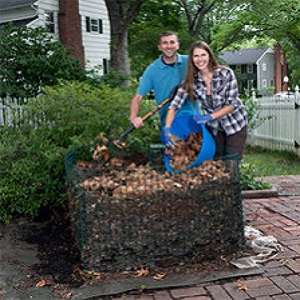Information to improve your compost long after the leaves have fallen.
Some people think of composting home and garden debris as recycling – a proactive way to use materials that otherwise would go into landfills. Once the composting process is complete, the compost can be used back in the garden to enrich the soil and reduce your carbon footprint.

Regardless of the reason, maximizing your composting efforts is important, according to Dennis Patton, K-State Research and Extension horticulture agent. Fall may seem like an odd time to compost, but this may be the best time of year.
“To a gardener, composting is black gold,” said Patton, who is based in Johnson County. It’s also a great way to get rid of organic debris that comes from lawns, gardens and leaves.
Compost, including shredded leaves, can be used as mulch, plus working it into the soil provides nutrients and loosens heavy clays typical in Kansas soils.
“Composting is a living, breathing process,” Patton said. Microorganisms in the compost break down and chew the materials, so, it’s important to provide an environment that supports the microorganisms.
Start with the bin and build from there
“The bin is something that holds the massive material of the compost so it can be anything from a purchased system to four old wooden pallets to a four-foot circle of heavy duty gauge wire,” he said. “It is just something to hold the material. It does need some circulation because it is a living, breathing mass.”
When starting a compost pile, the base or bottom layer falls into two categories - greens and browns. Browns are items like leaf debris and other dry plant material. Greens are fresh grass clippings and manure.
“Gardeners should mix the greens and browns,” Patton said. “Unfortunately, many gardeners have a lot of browns and not a lot of greens.” Those gardeners must add green, possibly in the form of manure or garden fertilizer.
“When you build the compost you may want to put six to eight inches of dry brown, leaves another green layer and repeat,” he added.
It’s the combination of greens and browns that make composting work, Patton said. The microorganisms found in compost piles also need water and oxygen to survive and break down the materials in the compost.
Gardeners should keep the pile well hydrated throughout the process, including baking. Many times the inside of the pile can heat up to 150 degrees, a result of the microorganisms that are at work.
“It helps to turn the compost pile a couple of times,” Patton said. Once the temperature in the pile peaks (to 150 degrees F), turn it over so it can reheat again.
“The wonderful thing about composting is you can be active or passive,” he said. “The bottom line is passive and active management makes compost. However, the more you manage the pile the quicker you get it to become compost.”
Some items just don’t belong
Some materials should not be composted. Pet manure, including dog and cat waste, can transmit disease. Fats, greases and oils, including salad dressing, should be avoided, as should meat scraps that may attract animals.
“If there are tomato vines, pepper plants or anything else that has a lot of disease I recommend you keep that out of the compost bin,” Patton said. “The pile will heat up but it is not a sterilization process.”
Avoid adding crab grass and other weeds. It’s possible that their seeds will survive the composting process and when added back into the garden as compost, you will be spreading the weed seeds.
Source: k-state.edu